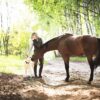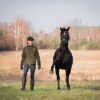Another big change in your attitude is to give your horse the True Autonomy.
Many people try to do this and they come to the conclusion that is is a wrong way, because they don’t have communication and there is no calmness and no safety when they are with their horses. When we give autonomy to the horse that is scared he will simply run away. When we give autonomy to the horse that feels anger or hatred, he will attack us or run away.
Remember that the mother of all misbehaviours and wrong ideas is being scared.
That is true for the horses as much as for the people. That is why before we can give any autonomy to our horses when they are with us, we need true calmness and 100% safety.
What is the real autonomy? This is very simple. We simply agree that the horse will do whatever he likes to do. And this simple idea scares almost all horse people. Why? I explained before, but to make it very clear I will repeat it again now: because people and horses are scared when they are together.
The solution people choose in this situation is to take away the autonomy from the horse. When you take away the autonomy from such intelligent and strong animal you have to be very strict. You need to take away 100% of the autonomy. If you leave even 1% of the autonomy in such case, the situation will be simply dangerous for you and your horse. The whole classical training system and whole traditional horsemanship is based on taking away 100% of the autonomy from the horse. The horse cannot decide when he moves, when he stands, what to do and when to do it. This leads to a well-known psychological phenomenon named learned helplessness. Learned helplessness means, for example, that when you keep your horse tied to the fence for a very long time and you will not allow him to move, in the future you can remove the rope and your horse will still not move, because he learned that trying to move is not effective. That is called learned helplessness. From my observation, this is the basic psychological “training method” used with horses.
Even many people who do “liberty training” take advantage of this simple phenomenon. And this can be very effective and safe to a point because the horse has been taught not to do anything “by himself”. You can say that the horse is “switched off” and like a zombie.
This situation also leads to many problems like lack of engagement, lack of energy, and lack of regularity in movement. That is why people are looking for horses that are good for the sport. In reality, that means that they can move “beautifully” even when in the state of being “switched off” and being a zombie. But experience teaches us that even the best and most expensive horses today after a few years have severe injuries or other health or behavioural problems.
The solution is very simple and very difficult at the same time.
The solution is to give the horse autonomy and build on this, his real engagement and motivation. But for many people this is simply impossible. Why? I explained before, but I will explain again. When your horse is afraid and you give him even 1% of autonomy he will try to escape the situation. That leads to all popular “misbehaviours”.
If your horse was trained using learned helplessness in practice, it means that he was trained in any “traditional way”. You have to be prepared that the calming period will take time and is very important. At the beginning, you will have doubts because your horse will start to “misbehave”. In reality, he will try to SHOUT OUT all fears and problems that he experienced before. From my experience, the longer the horse was treated badly, the longer you will have to calm him.
Don’t think “It does not apply to me”. It applies equally to all of us.
We all are humans, and we all are prone to make mistakes. It tells nothing about you and is not a judgment. This is reality that we have to face and start being honest about it in order to CHANGE. What I want from you now is to be prepared for this and to understand that you need to decide how you want to live with your horses.
What do I mean by autonomy? Autonomy is a very simple situation.
You agree that your horse can do whatever he likes to do. And you allow this to happen. You never think about your horses in terms of control. You are never disappointed when your horse does something opposite to what you had in mind. This is another important change that regards you. This is the state of mind that we need to be able to start teaching anything to your horse. There is no teaching when there is no autonomy. And we have to come back to safety again.
Many people that tried to do this and didn’t care about the horse’s psychology, and they were not successful. Horses are living in herds and they can be really calm only when they are together with someone wise and who will know what to do in case of any danger (disclaimer: this is not a science theory, this is my practical understanding of this subject). In effect, to calm your horse you have to prove that you are responsible for safety in the relation between you and your horse. In “horse language”, that means that you decide when and how your “group” is moving and what it is going to do. That doesn’t mean that you have to use any kind of force or scare your horse. That means that YOU have to have ideas on what to do next, and that your ideas have to be good, or even better than the ideas of your horse. What is a good idea? For your horse this is an idea that originates from the Nature. And when you are connected with your inner self all of your ideas originate from this field, and thus are highly seen by your horses.
Autonomy doesn’t mean “Do as you like, cause I don’t care about you”. Saying such thing is an abandonment, not an autonomy. Autonomy requires boundaries.
What does it mean in practice? In practice, it’s telling your spouse: “You can choose the destination of our holiday trip, but let’s go somewhere over the sea.” or telling your child “You can choose the toy I will buy you, but I have only $20 to spend on it”.
And how to give your horse autonomy and maintain the boundaries at the same time is going to be a huge part of this workshop.
You can agree that your horse is doing anything he wants but you have zero tolerance of any behaviour that is dangerous to you. Why?
Because we will practice during this workshop equal partnership – meaning that we will value and respect your life as much as we are going to value and respect the life of your horse.
We won’t feel superior to the horse at any point and we agree that he has the same right to influence the training process as we do, and that we will teach him using our best knowledge and 100% honest approach. But this also means that we will set boundaries and won’t accept behaviours that could be threatening to us because our life means as much as the life of our horse.
You have to be careful here because many horse behaviours look very nice at the beginning but they can very quickly change into something dangerous. For example, you can observe that your horse is running small circles around you and you can think “Oh, that is something I want”, but in the horse’s mind, he is constantly crossing your way and is changing the direction in which you can move. In such situations we have to be strict and we need to very quickly show our horse that we will decide when and where we move. What do I mean by “very strict”? This means that during this phase of training we will check constantly whether we can decide about our own movement and space around us. So you can expect a lot of exercises when we change direction, distance, speed, etc. Being very strict means that you will not allow your horse to decide where and where you move and about your space. This doesn’t require any offensive behaviour from your side, but this requires being consistent and decided.
Again, without calmness this is not possible.
When you or your horse are afraid you will be simply in flight mode or aggressive if the flight mode cannot be realised. All these acts originate from fear. So our first objective is to eliminate fear from you and your horse. When you give autonomy to your horse and your horse is becoming aggressive this is an indication that your horse is scared and probably frustrated.
You really have to be honest with yourself at this point and you have to check everything regarding your horse well-being and safety. From my experience, many horses kept by humans feel some sort of pain, especially often in their hooves or originating from the hooves, and our responsibility is to remove all kinds of physical or psychological pain from your horse’s life. If you cannot do this, you cannot give your horse any autonomy. This will be simply dangerous for you and your horse.
Removing pain from your horse’s life is not a difficult process. This is just a decision.
This is another change that I expect from you. I can tell you with 100% certainty that you cannot train with autonomy a horse that is in pain. Also I can tell you with 100% certainty that when you remove pain from your horse’s life, 90% of behavioural problems that you have with your horse today will magically disappear.
You need to remember here that horses are very good in hiding the pain and health problems.
For flight animals like horses health problems are indicators for predators to attack them. So this is your responsibility to find all these problems. And the best idea is to cooperate with specialists, but I will also give you some advice in this area during this workshop.
Coming back to autonomy: this is the foundation for any engagement, motivation, cooperation and partnership. Without autonomy, the only way you can train your horse is through learned helplessness and this is not what we are going to teach here. Please find a moment to think about the difference between teaching your horse something and putting him in the learned helplessness state.
The difference is autonomy.
When we teach, we give a choice and space to try things out and to make mistakes and reason from them. Also, we need to respect everything the horse is telling us.


